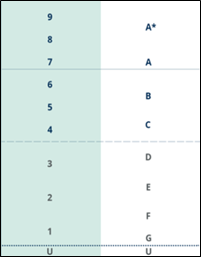- Home
- Curriculum
- Grading Structure
Grading Structure
Year 7, 8 and 9 Core Subjects
In Year 6, students are tested in both English and Mathematics and receive standardised scores which range from 80 (lowest) to 120 (highest), these scores are then used by the Government to predict the grades all students should achieve at the end of Year 11. Whether the student achieves this grade or not will determine the progress they have made over the previous five years. All Saints Academy use these Year 11 predicted grades to create a student flight path which allows yearly targets to be generated. Every student is given a bespoke end of Year target grade that is extrapolated from this end of Year 11 outcome and a student’s progress is then measured against this every term. If a student has either struggled to meet or has exceeded their end of Year target grade, then discussions will take place between the Head of Faculty and classroom teacher regarding how best to get the student back on track or whether the target grade needs amending for subsequent years.
The core subjects at the academy are:
English & Mathematics
The progress students make at All Saints Academy is ‘very good’. In 2023, Year 11 students who achieved both a grade 4 in English and Maths was 93% with 72% achieving a grade 5 in both English and Maths, the local authority average for 2023 was 47% and the national average was 45%. This also explains why the Academy is considered to be an outstanding provider of secondary education. Parents and students can monitor progress towards their yearly targets through the visual RAG rating system.
If a student is:
- Purple in any subject, indicates that a student is on track to finish the year with a grade higher than their end of Year target grade
- Green in any subject, indicates that the student is on track to meet their end of Year target grade
- Amber in any subject, indicates that a student is tracking slightly below the standard required to meet their end of Year target grade
- Red in any subject, indicates that the student is tracking well below the required level to meet their end of Year target grade
Where students are identified as red, their teachers will write an individual comment indicating how students can improve, which tutors feedback to parents and students during Academic Reviews. Some of the many interventions that may be offered to help get the students back on track will include the following: teacher led interventions, teaching/house assistant interventions and student mentoring.
Government guideline on the 9-1 grading system

DFE: ‘We have designed the grading so that there are comparable points at key grades. The bottom of a grade 7 is comparable to the bottom of the old grade A, the bottom of a new grade 4 is comparable to the bottom of the old grade C, and the bottom of the new grade 1 is comparable to the bottom of the old grade G. We have been clear to employers, universities and others that if they previously set entry requirements of at least a grade C, then the equivalent now would be to require at least grade 4’.
A grade 4 is known as a ‘Standard’ Pass. The C/grade 4 minimum currency will be raised to grade 5 by theGovernment and this is known as a ‘Strong’ Pass.
The Grading structure for Years 7,8 and 9 for both core and non-core subjects
In 2015 the Government issued a report called ‘Assessment without levels’, which allows schools to develop their own in-house grading system, to cater better for the needs of their students. Consequently, we changed the way students in Year 7 and 8 are allocated target and current working grades for subjects that are ‘non-core’ subjects. The ‘non-core’ subjects at All Saints Academy are:
These non-core subjects study the content required at Key Stage 3, this content will help the students in the examination subjects they study from Year 10. Very little GCSE theory content is covered in the non-core subjects during these years, which means giving the students a GCSE grade is unrealistic.
In contrast, within the core subjects’ students start to cover content that will be tested at GCSE level, from Year 7, so it becomes possible to give grades that reflect a GCSE grade that the student is working at.
The Pathways
Each student is allocated a Pathway to follow for the non-core subjects initially based on their Key Stage 2 grade. This is not a capped level, for example if the student is on Pathway 2, they can be moved onto Pathway 3 if they exceed the skills required for Pathway 2 by the end of the year. All students are targeted to be Secure on their assigned Pathway by the end of each academic year.
Each Pathway is broken down into 4 sub-divisions; emerging, developing, secure and exceeding, which allows students to see how they are progressing in each subject. These are linked to the assessment criteria sheets which each subject has created, these are available on Teams for students to access.
- Students targeted on Pathway 1 are likely to achieve a Grade 4 in their GCSEs in Year 11
- Students targeted on Pathway 2 are likely to achieve a Grade between a 4 and 7
- Students targeted on Pathway 3 are likely to achieve a Grade between a 7 and 9
The diagram below shows the pathways and their final outcomes in Year 11.



